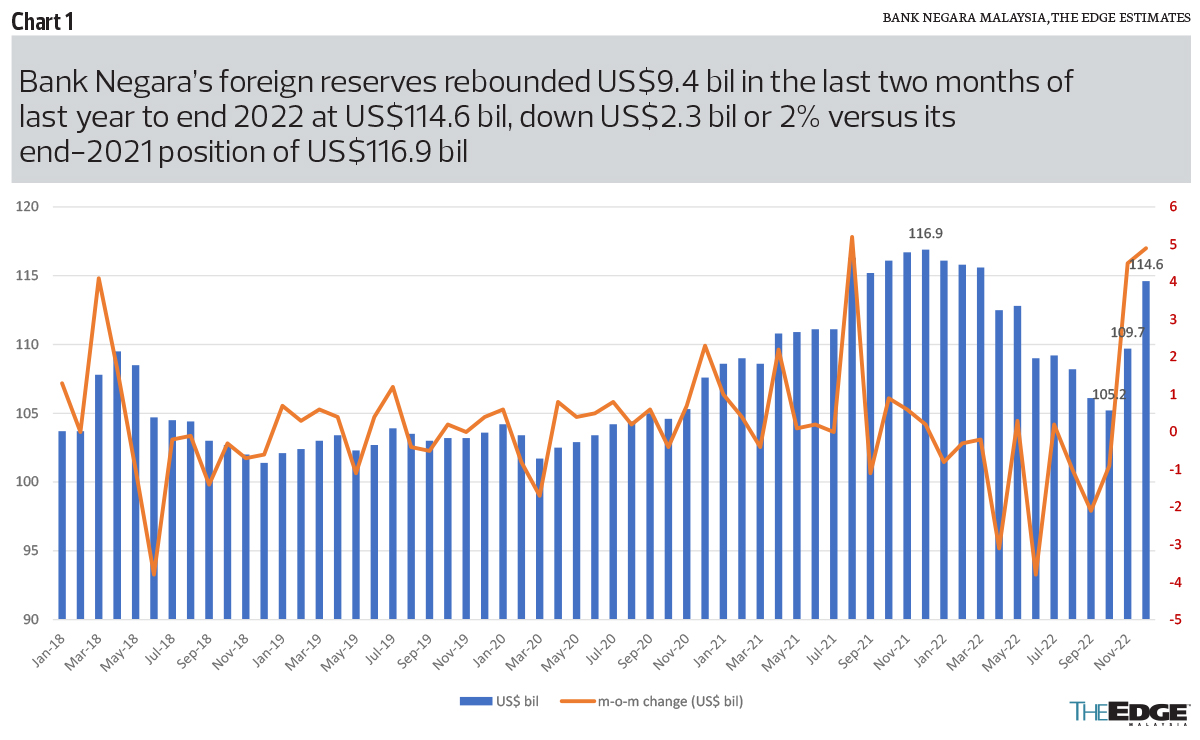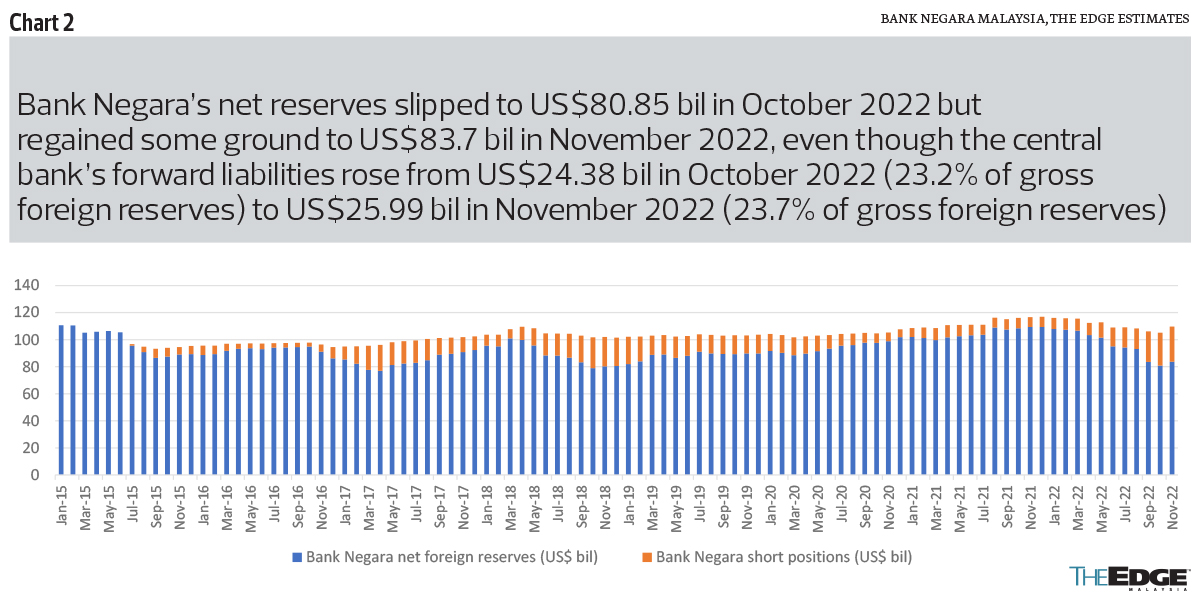
This article first appeared in The Edge Malaysia Weekly on January 30, 2023 - February 5, 2023
WITH Malaysia seeing sizeable portfolio outflows in the last quarter of 2022 — as foreign money withdrew from many emerging markets across multiple asset classes in a strong US dollar environment — the fact that Bank Negara Malaysia’s foreign reserves gained more in the month of November itself than the amount it lost over three months between August and October last year did not go unnoticed.
Specifically, Bank Negara’s foreign reserves climbed US$4.5 billion in November to end the month at US$109.7 billion. That more than made up for the US$4 billion it lost from US$109.2 billion at end-July.
In December, Bank Negara’s foreign reserves gained even more ground, adding US$4.9 billion in the last month of the year to end 2022 at US$114.6 billion. That’s no small feat, even though reserves were still around US$2.3 billion or about 2% shy of the US$116.89 billion the central bank had as at end-2021, having gained US$9.3 billion that year. (See Chart 1.)
The US$4.9 billion monthly gain in reserves booked in December 2022 was the highest in a single month since April 2011 when a rare US$16.1 billion month-on-month (m-o-m) gain was recorded, if one were to exclude the US$5.2 billion gain in August 2021 when Bank Negara booked US$5 billion worth of special drawing rights (SDRs) that formed 0.77% of a US$650 billion global facility from the International Monetary Fund (IMF) to bolster liquidity in the global financial system, The Edge’s compilation of central bank data shows.
“A key driver for higher foreign reserves in 4Q2022 is foreign exchange revaluation amid a weaker US dollar while bond prices also rebounded. The US dollar index (DXY) plunged 7.7% in 4Q2022. This is a reversal from 1H2022, when a sharp repricing in foreign exchange and bond prices likely accounted for most of the change in Malaysia’s foreign reserves,” says Winson Phoon, head of fixed income research at Maybank Investment Banking Group in Singapore.
Apart from the “sizeable revaluation effect” in 4Q2022, Phoon also notes that foreign flows “had actually turned positive” for Malaysian Government Securities (MGS) and the shariah-compliant Government Investment Issues (GII) in November and December, but “were offset by larger outflows from short-term bills”.
“The market has started the year strongly, for both ringgit bonds and forex, and we might see net foreign inflow for ringgit bonds in January if the conducive sentiment extends into the rest of the month,” Phoon adds, noting that China’s reopening is “ringgit positive, given close trade relationships, potential increase in tourist arrivals and a reasonably high correlation between the ringgit and Chinese yuan”.
In a note dated Jan 10 headlined “Malaysia: Further Portfolio Outflows but Foreign Reserves Rose in Dec”, UOB Bank Malaysia senior economist Julia Goh and economist Loke Siew Ting tell clients that “The gains in reserves could be attributed to a robust current account surplus and ongoing FDI (foreign direct investment) flows, as well as less pressure on the ringgit. The pullback in USD across December as the Fed (US Federal Reserve) slowed its rate hikes coupled with China’s easing of Covid restrictions were also supportive of the ringgit momentum”.
While the foreign portfolio outflows in December were “broad-based”, led by a RM1.5 billion outflow from equities and RM0.9 billion from debt securities, the UOB economists note that the total non-resident portfolio outflows for the full year of RM5.6 billion “were solely driven by debt outflows [of RM9.8 billion across all debt instruments, with GII (-RM4.3 billion) and MGS (-RM3.5 billion) recording the biggest outflows] as the equities segment recorded cumulative inflows of RM4.2 billion last year”. The RM7.8 billion that flowed out of Malaysian government bonds last year was the first full-year outflow since 2018, they add, noting that RM31.8 billion had flowed into government papers in 2021.
The UOB economists also note that Bank Negara’s net short position in forex swaps increased for the 12th consecutive month “by US$1.6 billion m-o-m to another record high of US$26 billion (23.7% of total foreign reserves) as at end-November [marking] the longest streak of increases for net short position since data began in April 2000, due to the combined impacts of the Fed’s rate hike cycle and China’s deteriorating growth outlook on the ringgit during the year”.
Indeed, Bank Negara’s short positions in forward swaps have increased every month since November 2021 in absolute US dollar terms and as a percentage of the central bank’s headline foreign reserves, central bank data shows.
Whether the trend continued in December would only be known when numbers are released by Bank Negara at the end of this month.
The Edge wrote about Bank Negara’s growing forward liabilities when data for October was released at end-November, in the article headlined “Ringgit sees nascent recovery, and why it is not blue skies just yet for the currency” in Issue 1450, Dec 5, 2022. (Scan the QR code to read the story.)
At the time, Maybank’s Phoon told The Edge that he expected Bank Negara to pare down some of its forward net shorts and rebuild buffers when the ringgit was hovering at firmer levels.
Asked about this, Phoon says: “It was probably a matter of choice between prioritising raising headline reserves and reducing net shorts in foreign exchange forwards”. That, he explains, is because central banks can either utilise reserves or US dollar liquidity from the forex swaps to intervene in the market during challenging market conditions and, as such, can choose whether to rebuild reserves or pare down the net short positions when market sentiment improves.
While December data will only be released on Jan 31, Phoon reckons that Bank Negara’s net foreign reserves — headline total reserves less net short position in forex forwards — should have not only “risen strongly” in November but also in December.
For now, at least, the central bank’s focus “appears to be more on rebuilding the headline reserves first rather than paring down the net short position in the forex forward book”. The latter, Phoon believes, “will come eventually”.
Indeed, this can be seen from how Bank Negara had previously wound down its net short positions once volatility dissipates.
For now, due to the increase in these forward swap positions, the central bank’s net reserves have been on a steady downtrend since November 2021, falling from US$109.4 billion in November 2021 to US$80.85 billion in October 2022. In November, net reserves rose to US$83.71 billion, even as the m-o-m growth in (gross) foreign reserves was higher than the m-o-m growth in forward swaps. (See Chart 2.)
That said, neither Phoon nor the UOB economists flagged concerns over reserve adequacy.
Bank Negara’s reserves of US$114.6 billion as at end-December 2022 are sufficient to finance 5.2 months of imports of goods and services (versus the generally-accepted “rule of thumb” adequacy threshold of three months) and are 1.0 time total short-term external debt, UOB says.
“Going forward, we expect financial market volatility to persist but the prospects of foreign buying interest returning to emerging market (EM) assets have somewhat brightened following China’s reopening from Jan 8, 2023. The current market expectations for the Fed reaching the peak of its interest rate hike cycle by 1Q2023 alongside a continuation of China’s economic stimulus and consensus of still positive growth outlook for most Asian countries versus a projected mild recession in major advanced economies have also augured well for EM currencies including the ringgit,” the UOB economists add.
Save by subscribing to us for your print and/or digital copy.
P/S: The Edge is also available on Apple's App Store and Android's Google Play.



